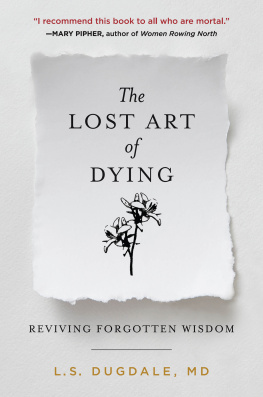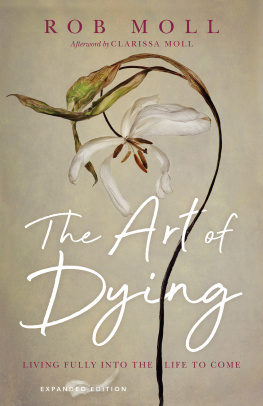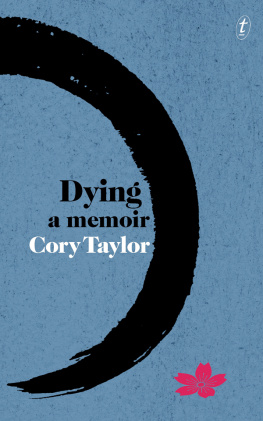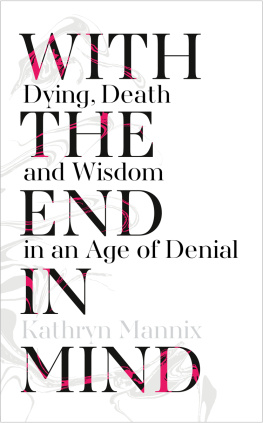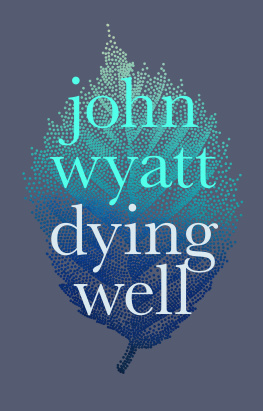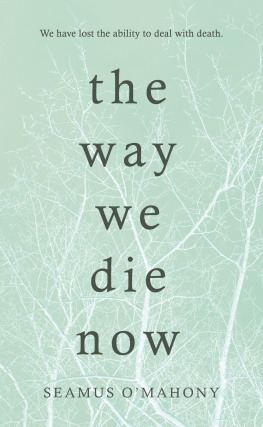Contents
Guide
For my patients
and
In memory of my grandmother
Ella May Newkirk Ulrich
April 22, 1921March 29, 2019
Contents
I regret that we resuscitated Mr. W. J. Turner. He was a little old man, aged further by the cancer that had invaded his bones and lungs and brain. He had eluded death for so long that his daughters had begun to whisper of his immortality. They believed, or so they told themselves, that he might live forever.
When his organs began to shut down like falling dominos, he was admitted to the oncology ward at my hospital. His daughters assured the medical team that he would beat this cancer. They told the nurses, Do everything you can to keep him alive. The night Mr. Turner died, none of us knew for certain whether his family understood the immensity of his disease or the misery that would doubtless accompany his prognosis.
I had never met Mr. Turner. In fact, in that uncanny set of circumstances only experienced by doctors and emergency medical technicians, I encountered his dead body before I met him. Human corpse before human being. Death before life.
I was talking with a patient in our emergency room when the code alarm sounded. A college student with asthma was attempting to explain the impetus for her hospital visit in two-word increments. She hadwheezebeen at awheezeparty and her friendswheezewere...
Code Blue, Nine West! Code Blue, Nine West! An authoritative voice from the hospitals overhead speaker system interrupted the wheezing. These broadcasts always sounded the same, the voice steady and deep, unfazed by the fact of death.
Thats me. Have to run. Back later, I blurted, racing to the elevator. It was faster to take the elevator than the stairs to any code above the fourth floorespecially in the middle of the night. As the elevator doors parted, a fellow member of the code team, Amit, greeted me. Wonder if we know the patient, he said. Man, codes on the cancer floor are always bad.
He was right. The cancer ward rarely felt hopefulat least to us doctors. The patients were desperately sick, often having failed chemotherapy or radiation. It felt like an eternal winterfull of bulbs that never blossom.
Medical professionals are partly culpable for engineering such circumstances. We have mastered the art of offering third- and fourth-line chemotherapies for ostensibly untreatable cancers. We tell ourselves that we want to give hope, but a last-ditch effort at chemotherapy is rarely the hope our dying patients need. By focusing on fixes, we ignore finitude. And we accompany our patients to their deaths in the hospital with chemotherapy coursing through their veins.
I sighed when I reached Mr. Turners emaciated body lying cruciform on the hospital bed. This wouldnt go well. Why resuscitate? Everyone shared the thought, but no one said it. His pale brown skin was stretched tautly over a skeletal frame. The lifeblood drained, his body was cool to the touch.
We quickly established hierarchy, the reigning principle of the teaching hospital. The senior, or attending, physician bears moral and legal responsibility for a patients care and oversees the team of students and doctors at various levels of training. The attending physician is followedin decreasing order of seniorityby the fellow, the senior resident, and the junior resident or intern. Then come the students from across the health professions. Nurses, therapists, chaplains, and social workers round out the crew. This team approach guarantees multiple levels of oversight and ensures that someone who knows the patient will nearly always be in the hospital.
The intern that night knew Mr. Turner best and began to tell his story while those of us assigned to the task of resuscitation began our work. Eighty-eight-year-old man, history of metastatic prostate cancer, status postradical prostatectomy, chemo, and radiation, readmitted two weeks ago with worsening mental status and bone pain, found to have new brain and bone mets. Without flinching, he delivered this medicalized eulogy for a medicalized death.
The head of our code team asked me to insert the central linea large catheterinto a main blood vessel in the groin. Through this line we would push medications to stimulate the heart. Two other doctors were attempting to introduce a breathing tube into Mr. Turners airway. One doctor kneeled over the body as he compressed cancer-laden ribs. Another prepared to shock the heart electrically. Nurses worked at placing an intravenous line in the arm and dispensing medications that sometimes help to revive the dead.
We labored efficiently and with precision. We had perfected the knowledge and technique for resuscitating dead bodies. Although the odds were against us, it worked. Ive got a pulse, Amit said.
We all paused. The pulse did not waver, and the nurse manager took charge. Okay. Lets get his bed cleaned up and get this man to the ICU. Mr. Turner was a man again, a human being, no longer a human corpse. Being, the present participle of be, implies existence. He was alive. We had forced life into his lifeless body.
Patients whose cardiopulmonary resuscitation (CPR) is successful are always transferred to intensive care. This is because the very act of pulmonary resuscitation requires the insertion of a breathing tube into the patients airway. This tube then attaches to a mechanical ventilator that breathes for the patient until the lungs prove their independence. Ventilators require the around-the-clock staffing and monitoring of the intensive-care unit (ICU).
Resuscitation complete, Amit and I tore off our paper gowns and latex-free gloves. We wiped the sweat from our foreheads. Our bodies had assumed various contorted postures during the twenty or so minutes we had worked to resuscitate Mr. Turner, and now we straightened our crooked frames.
Cant believe we got him back.
Ill call the family, I said.
And that was it. Having checked revive the dead off our to-do list, we dispersed to other duties.
I waited in the ICU until Mr. Turners daughters arrived. Even though I wasnt his primary physician, I wanted to talk with them. I doubted that they had been told that he was dying and that his cancer was consuming him. They needed to know. There was no question that his heart would stop again, probably soon, and I hated to think of repeating what had just occurred. All the life support in the world couldnt ultimately save him.
His family appeared promptlyhair and clothing so well assembled that one would hardly guess they had been sleeping just minutes before.
We sat together in the fishbowl, a glass-walled conference room close to Mr. Turners bed. I explained what had happened. They thanked us for saving his life. I reiterated, gently, that there was no doubt that his cancer was killing him and that his heart would not likely hold out under the stress of the disease. I asked whether they would consider going without cardiac resuscitation, were his heart to stop again.
The eldest daughter did not flinch. No, Doctor, she replied. We are Christians, and we believe that Jesus can heal. We believe in miracles. You do whatever you can to keep him alive.
This has always struck me as something of a paradox. It seems curious that the people who believe most fervently in divine healing also cling most doggedly to the technology of mortals.
Aggressive Measures
But Mr. Turners daughters arent the only religious people who choose aggressive measures. The sentiment is, in fact, quite common among the devout. A recent Harvard study found that patients with high levels of support from their religious communities are more likely to choose aggressive life support and to die in intensive-care units. They were also less likely to enroll in hospice. Why might this be?
Next page
